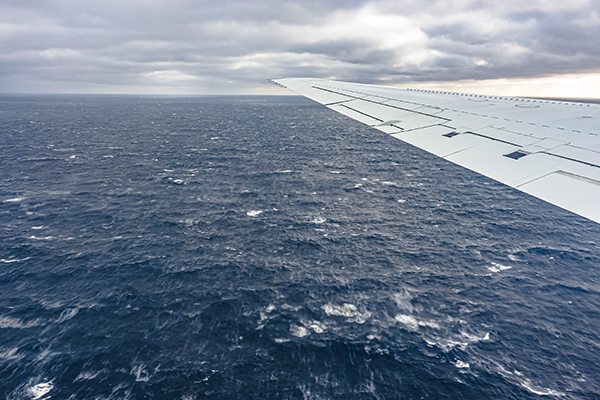A .gov website belongs to an official government organization in the United States.
A lock () or https:// means you've safely connected to the .gov website. Share sensitive information only on official, secure websites.
26 August 2024 Organic contributions from ocean organisms are sparse in sea spray, helping to clarify predictions of its impact on the climate. When waves break on the open ocean, they throw particles called sea spray aerosols into the atmosphere. These particles can be lifted kilometers into the air, where they may affect how clouds form and therefore Earth's radiative balance. This balance between the amount of radiant energy Earth's surface and atmosphere emit, absorb, and reflect strongly affects climate. Sea spray aerosols – the most abundant natural aerosol in Earth's atmosphere – are made up primarily of salt, but they can also contain traces of other chemical compounds, and even biologically produced proteins and sugars. These molecules from ocean organisms may change how aerosols affect Earth's climate, and even plant and animal health, by modifying the particles' sizes, concentration, chemistry, and tendency to take up water. But previous studies haven't conclusively established average levels of organic content in sea spray. Researchers address that shortcoming, using data from four deployments of the NOAA Particle Analysis by Laser Mass Spectrometry (PALMS) instrument during NASA's Atmospheric Tomography (ATom) mission over remote areas of the Atlantic and Pacific oceans between 2016 and 2018. PALMS measured the mass of organic molecules in the sampled aerosols, allowing the researchers to deduce the extent to which life influences the composition of sea spray aerosols. They found that overall, the organic mass fraction of sea spray aerosols is low (less than 10% in most cases), though smaller particles had higher proportions of organics. They also found little seasonal variability in the organic mass fraction, a strong sign that living organisms, the abundance of which waxes and wanes with the seasons, weren't much involved. Two exceptions were in the Canadian Arctic and the southern middle to high latitudes, where the researchers saw summertime maximums in the organic mass fraction. Lead author Mike Lawler, a CIRES atmospheric scientist working at NOAA CSL, and co-authors also found a much larger organic component of sea spray aerosols higher in the troposphere, which they say is likely because of atmospheric chemical reactions, not the original makeup of the aerosols emitted by ocean waves. Future topics to be addressed include the role of organic molecules in the production of very small (smaller than 0.2 micrometer) sea spray aerosols, as well as better reconciling observations and numerical models of organics in sea spray aerosols. Lawler, M.J., G.P. Schill, C.A. Brock, K.D. Froyd, C. Williamson, A. Kupc, and D.M. Murphy, Sea spray aerosol over the remote oceans has low organic content, AGU Advances, doi:10.1029/2024AV001215, 2024. Biogenic organic compounds in the surface ocean may significantly alter the cloud-forming ability of sea spray aerosol and thereby affect the amount of solar radiation reaching the ocean surface. Estimates of the organic mass fraction of sea spray vary widely, and some results show a significant dependence on biological activity in the source seawater. We present airborne observations of the organic mass fraction of individual sea spray particles measured using the Particle Analysis by Laser Mass Spectrometry (PALMS) instrument during the Atmospheric Tomography (ATom) mission, which sampled a wide range of latitudes and altitudes over the remote Atlantic and Pacific Oceans across four seasons, from the marine boundary layer to the upper troposphere. The measured sea spray particles of about 0.15–0.7 μm dry diameter showed higher average organic mass fractions at smaller sizes, but values were low overall, with regional integrated submicron means almost always <10%. Atmospheric aging adds organics to sea spray particles, leading to higher mean organic mass fractions (sometimes exceeding 50%) in the free troposphere than in the marine boundary layer. The average submicron sea spray organic mass fractions are on the low end of previously reported values and show weak seasonal variability for most regions. These results imply that recent biological activity in the surface ocean has only weak control over how much organic matter is in nascent submicron sea spray particles over the remote oceans, in contrast to findings from some observational studies and global numerical simulations.2024 News & Events
Ocean Spray Is Relatively Lifeless
adapted from Eos Science News by AGU
Abstract